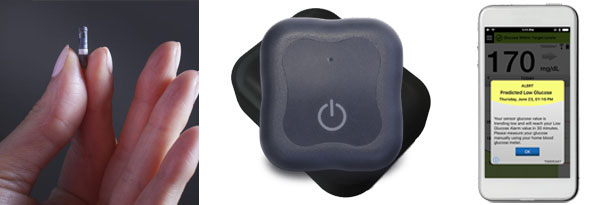Senseonics Inc, based in Germantown, MD, received approval from an FDA advisory panel on March 29, 2018 for its entirely implantable 90-day continuous glucose monitoring system called Eversense. The Eversense CGM system has been available in Europe since 2016 where Senseonics recently launched an extended length 180-day version. Depending on final FDA approval, Eversense may become available in the US sometime in the middle of 2018. Senseonics hopes to start studies for approval of the 180-day version this summer.
Senseonics Inc, based in Germantown, MD, received approval from an FDA advisory panel on March 29, 2018 for its entirely implantable 90-day continuous glucose monitoring system called Eversense. The Eversense CGM system has been available in Europe since 2016 where Senseonics recently launched an extended length 180-day version. Depending on final FDA approval, Eversense may become available in the US sometime in the middle of 2018. Senseonics hopes to start studies for approval of the 180-day version this summer.
The small implanted sensor, encased within a biocompatible material, has a light emitting diode that lights up glucose molecules that contact a fluorescence-based glucose. The biocompatible material keeps the body from rejecting the sensor. Changes in glucose concentration are rapidly detected by changes in fluorescence output. This detection method is said to be highly accurate because the sensor is designed to respond specifically to glucose, yet not be significantly affected by other substances at concentrations typically present in interstitial fluid. Interstitial glucose measurements closely correlate with blood glucose values.
The 3 mm by 16 mm sensor is implanted and removed by a physician just below the skin on the upper arm or abdomen (with no skin protrusion). There are currently 90 day and 180-day versions. The sensor is calibrated with 2 fingerstick values a day. A separate, rechargeable transmitter is worn over the implanted sensor to activate the glucose measurement process and transmit readings every few minutes. The transmitter is attached using an acrylic-based adhesive patch that must be changed every day. The transmitter calculates the glucose concentration and sends this to a smartphone via Bluetooth LE. If you are out of range of your phone, the transmitter can provide vibration alarms for highs and lows, an excellent addition for people who are visually impaired or have difficulty hearing.

Senseonics has partnered with Sagentia, Inc for their medically regulated iPhone app. Sagentia also provides expertise with Bluetooth LE connectivity between the mobile app and the CGM system. The smartphone app provides easy access to real-time glucose measurements in a device most people already carry. The app shows the glucose value, the rate and direction of glucose change, and graphical trends. Audio alerts sound for hypo- or hyperglycemia on a smartphone, along with direct vibration alerts from the implanted sensor. Data can be directly shared and is also be stored for later analysis. The smartphone app also allows entry of relevant daily events such as meals (carbs), insulin doses, health events, etc. All of the data is stored in the browser-based Eversense Data Management System.
